In Search of the Earliest Fairy Wings December 17, 2016
Author: Beach Combing | in : Modern , trackback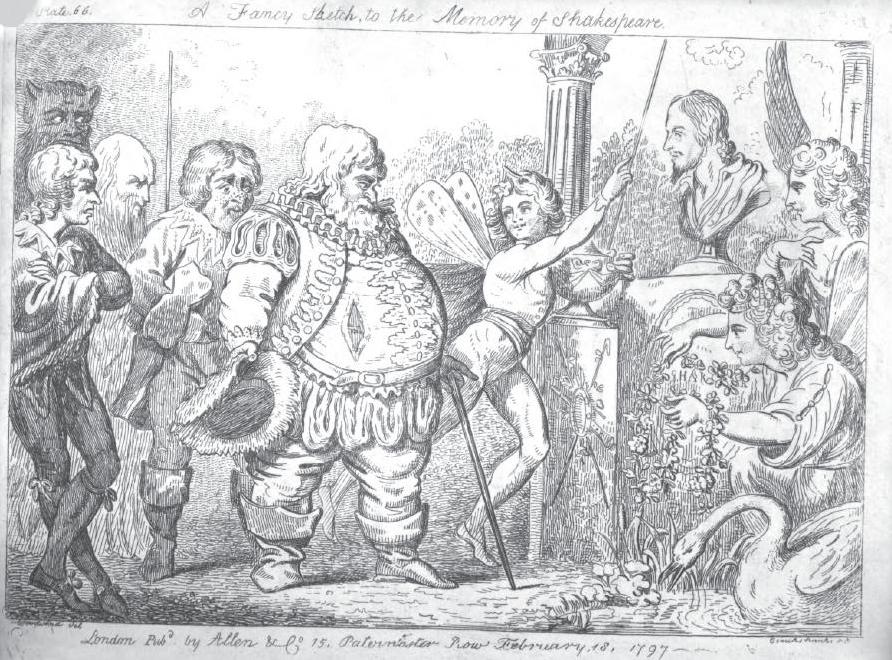
Next year Beach has to write an article on the history of fairy wings, something that he is greatly looking forward to: for absolute beginners fairies were not shown with wings until relatively recent times. There are three big historical questions: (i) when were fairies first portrayed in art or literature as wearing fairy wings; (ii) when did people dressing up as fairies first start wearing wings; and (iii) when did people seeing fairies first start seeing them with wings? Beach’s provisional answer for the UK would have been, before this morning, respectively, late 18C; late-mid 19C, and early 20C.
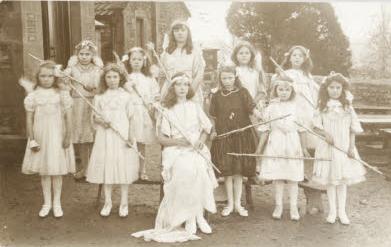
Beach is, in any case, primed to take fairy wing stimuli very seriously and at 6 am he woke up to see this image from Chris at Haunted Ohio Books. It looks, to Beach, like an Edwardian party shot, which shows little girls wearing fairy wings before the Great War. Now, in itself this is nothing strange. We have newspaper reports from the late 19C where there is reference to fairy kids on stage with wings. For example, one report from 1892 describes young girls ‘dressed as fairies with wings, wands, and all the usual paraphernalia’, which suggests that the custom was well established by then.
However, he, then, stimulated, ran this morning into the print heading the page from 1796. It shows a scene from Shakespeare and Beach is guessing the Merry Wives with Falstaff and a fairy. (Who is Chewbacca top left?) Beach would take this image to show that a fairy could quite naturally be portrayed on stage with wings in the late eighteenth century: though admittedly the illustrator and the author do not describe the image as being taken directly from a play. Perhaps in the end the tripartite question above is wrong. It is right to image that there would be be a gap between fairies being drawn with wings and being seen with wings. There most certainly was and it can be demonstrated. But there need be no such gap – why should there be? – between fairies being drawn with wings and little girls or boys being dressed up with wings.
Can anyone go earlier than 1796 for dressing up: drbeachcombing At yahoo DOT com
Oh and in celebration of character, from the series that Chris found… ‘Are you looking at my wand, buster?’ It is (just) conceivable that Tinkerbell here is still alive and giving her neighbours hell today. Let’s hope so.
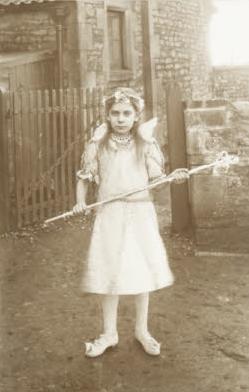
17 Dec 2016: Invisible goes wide…
Cleverly evading your actual question about the earliest depiction of fairies with wings, I think we need to look first at the whole idea of little creatures with wings. My money’s on Medieval winged devils or possibly Renaissance putti and/or the children with wings in 16th and 17th century entertainments. Of course, illustrations of said entertainments are scarce. Probably the best known is the biographical portrait of Sir Henry Unton at the National Portrait Gallery, 1596, part of which shows a masque being enacted at his wedding, which includes multiple children in wings. Obviously they are depictions of Eros or Cupids or something else allegorical, but the point is, small winged creatures have been a feature of theatre and religious culture much earlier than the 19th or even 18th century.
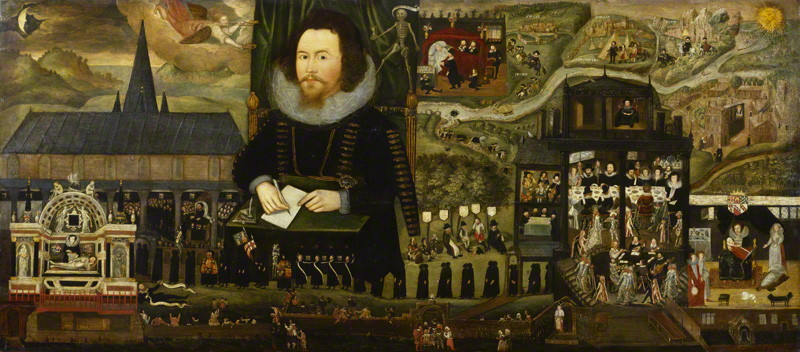
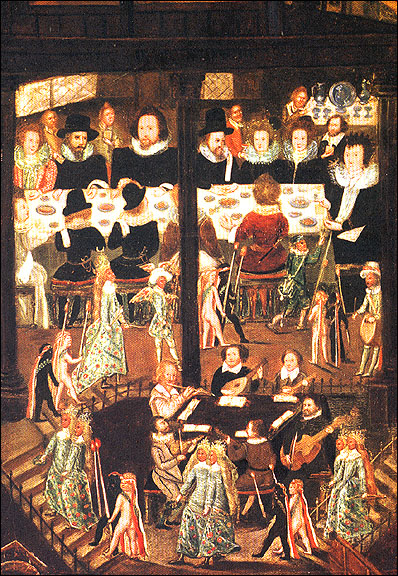
There is an absurdly baroque miniature in the V&A depicting Madame de Montespan and her son the Duc de Maine, c. 1690. The fantastic setting swarms with putti. But the little boy, being bathed in the pool by a putto, also wears wings, which, unless we have been grossly misinformed about the blood-line of Louis XIV [!!!!!!!!!!!!!!!!!!!!!!!!!!!!], are the only artificial wings in the picture. Can we assume that these prototypes of modern glitter-spangled sheer nylon fairy wings were available at the court of a King who loved theatre and dressing up? Or is this just the artist’s fancy?
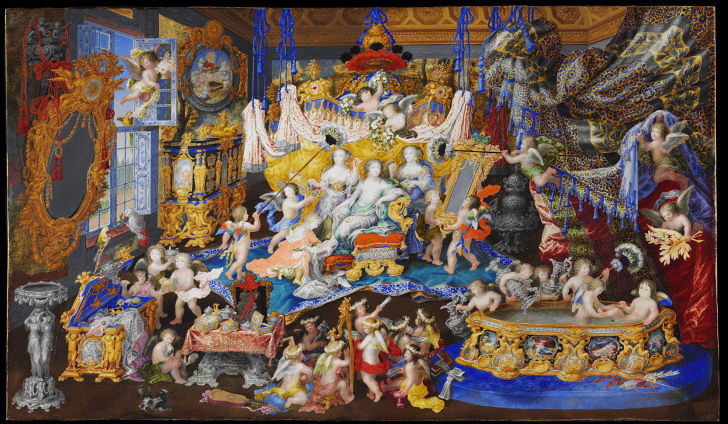

Here are a couple of examples of children with wings in a religious context:
In Lisbon, 1755: ‘Processions of priests and friars, with lighted wax tapers, were almost of daily occurrence. One of these was led by three popish dignitaries in scarlet clothes, followed by two little boys with wings fixed on their shoulders to make them resemble angels’. The Life and Times of the Rev. John Wesley, Founder of the Methodists, L. Tyemann, 1890
This is an excerpt from the autobiographical novel, The Improvisatore; or, Life in Italy, From the Danish of Hans Christian Andersen, 1835
‘Choristers swung the censer before the host, the most beautiful girls of the country followed, with garlands of flowers in their hands, and poor children, with wings to their naked shoulders, sang hymns, as of angels whilst awaiting the arrival of the procession at the high altar.’
Obviously someone was making these wings for use in religious pageants. Even if they were not officially fairy wings, the visual concept seems to have made its way into fairy circles, as it were. Given some 19th c Spiritualist/Theosophist reports of angel-like fairies or fairy-like angels, it would be surprising if this overlap did not occur earlier.
Perhaps a significant detail is that the wings depicted in these early winged pictures are small, like something that could be actually worn by a child on stage, a trend we see in the Edwardian girls costumed for their school fairy play. If fairy wings sprang as an artistic convention, fully fledged from the forehead of a 19th-century Oberon, wouldn’t we expect them to be more like angel wings or perhaps bird or butterfly wings?
The fairy queen clutching her wand like a spear is one of my favorite fairy images. That series of photographs is interesting for its nearly uniform depiction of fairies. Considering that this was home-made (or assembled) fancy-dress, the Christmas/pantomime/storybook fairy image was firmly entrenched–and bristling with wands! The other image is (I believe) the only one of the sequence that includes a girl in a dark dress. You can practically see her humiliation at not having the standard white dress.’
Thanks, extraordinary stuff.


